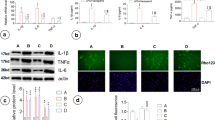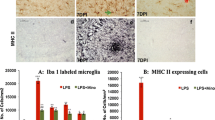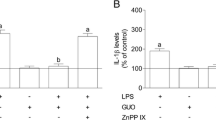Abstract
Astrocytes play multiple important roles in brain physiology. However, depending on the stimuli, astrocytes may exacerbate inflammatory reactions, contributing to the development and progression of neurological diseases. Therefore, therapies targeting astrocytes represent a promising area for the development of new brain drugs. Thiazolidinones are heterocyclic compounds that have a sulfur and nitrogen atom and a carbonyl group in the ring and represent a class of compounds of great scientific interest due to their pharmacological properties. The aim of this study was to investigate the effect of 3-(3-(diethylamino)propyl)-2-(4-(methylthio)phenyl)thiazolidin-4-one (DS27) on cell proliferation and morphology, oxidative stress parameters, activity of the enzymes ectonucleotidases and acetylcholinesterase (AChE) and interleukin 6 (IL-6) levels in primary astrocyte cultures treated with lipopolysaccharide (LPS), to model neuroinflammation. The astrocyte culture was exposed to LPS (10 μg/ml) for 3 h and subsequently treated with compound DS27 for 24 and 48 h (concentrations ranging to 10–100 μM). LPS induced an increase in astrocyte proliferation, AChE activity, IL-6 levels, oxidative damage, ATP and ADP and a reduction in AMP hydrolysis in rat primary astrocyte cultures. DS27 treatment was effective in reversing these alterations induced by LPS. Our findings demonstrated that DS27 is able to modulate cholinergic and purinergic signaling, redox status, and the levels of pro-inflammatory cytokines in LPS-induced astrocyte damage. These glioprotective effects of DS27 may be very important for improving neuroinflammation, which is associated with many brain diseases.








Similar content being viewed by others
References
Aebi H (1984) [13] Catalase in vitro. Methods Enzymol 105:121–126. https://doi.org/10.1016/S0076-6879(84)05016-3
Aksenov MY, Markesbery WR (2001) Changes in thiol content and expression of glutathione redox system genes in the hippocampus and cerebellum in Alzheimer’s disease. Neurosci Lett 302:141–145. https://doi.org/10.1016/S0304-3940(01)01636-6
Albuquerque EX, Pereira EFR, Alkondon M, Rogers SW (2009) Mammalian nicotinicacetylcholine receptors: from structure to function. Physiol Rev 89:73–120. https://doi.org/10.1152/physrev.00015.2008
Apotrosoaei M, Vasincu I, Constantin S et al (2014) Synthesis, characterization and antioxidant activity of some new thiazolidin-4-one derivatives. Rev Med Chir Soc Med Nat Iasi 118:213–218
Ballard C, Greig N, Guillozet-Bongaarts A et al (2005) Cholinesterases: roles in the brain during health and disease. Curr Alzheimer Res 2:307–318. https://doi.org/10.2174/1567205054367838
Batista CRA, Gomes GF, Candelario-Jalil E et al (2019) Lipopolysaccharide-induced neuroinflammation as a bridge to understand neurodegeneration. Int J Mol Sci. https://doi.org/10.3390/ijms20092293
Bjelobaba I, Parabucki A, Lavrnja I et al (2011) Dynamic changes in the expression pattern of ecto-5’-nucleotidase in the rat model of cortical stab injury. J Neurosci Res 89:862–873. https://doi.org/10.1002/jnr.22599
Blaser H, Dostert C, Mak TW, Brenner D (2016) TNF and ROS crosstalk in Inflammation. Trends Cell Biol 26:249–261. https://doi.org/10.1016/j.tcb.2015.12.002
Bohnen NI, Albin RL (2011) The cholinergic system and Parkinson disease. Behav Brain Res 221:564–573. https://doi.org/10.1016/j.bbr.2009.12.048
Bosenbecker J, Bareño VDO, Difabio R et al (2014) Synthesis and antioxidant activity of 3-(pyridin-2-ylmethyl)-1,3-thiazinan(thiazolidin)-4-ones. J Biochem Mol Toxicol 28:425–432. https://doi.org/10.1002/jbt.21581
Boué-Grabot E, Pankratov Y (2017) Modulation of central synapses by astrocyte released ATP and postsynaptic P2X receptors. Neural Plast 2017:9452275. https://doi.org/10.1155/2017/9454275
Bours MJL, Swennen ELR, Di Virgilio F et al (2006) Adenosine 5′-triphosphate and adenosine as endogenous signaling molecules in immunity and inflammation. Pharmacol Ther 112:358–404. https://doi.org/10.1016/j.pharmthera.2005.04.013
Bradford MM (1976) A rapid and sensitive method for the quantitation of microgram quantities of protein utilizing the principle of protein-dye binding. Anal Biochem 72:248–254. https://doi.org/10.1016/0003-2697(76)90527-3
Brisevac D, Bajic A, Bjelobaba I et al (2013) Expression of ecto-nucleoside triphosphate diphosphohydrolase1-3 (NTPDase1-3) by cortical astrocytes after exposure to pro-inflammatory factors in vitro. J Mol Neurosci 51:871–879. https://doi.org/10.1007/s12031-013-0088-3
Brisevac D, Bjelobaba I, Bajic A et al (2012) Regulation of ecto-5′-nucleotidase (CD73) in cultured cortical astrocytes by different inflammatory factors. Neurochem Int 61:681–688. https://doi.org/10.1016/j.neuint.2012.06.017
Burnstock G (2006) Historical review: ATP as neurotramistters. Trens Pharmacol Sci 27:166–176. https://doi.org/10.1016/j.tips.2006.01.005
Burnstock G (2020) Introduction to purinergic signalling in the brain. In: Barańska J (ed) Advances in experimental medicine and biology, 2nd edn. Springer, Cham, pp 1–12
Chan KM, Delfert D, Junger KD (1986) A direct colorimetric assay for Ca2+-stimulated ATPase activity. Anal Biochem 157:375–380. https://doi.org/10.1016/0003-2697(86)90640-8
Che DN, Cho BO, Kim JS, Shin JY, Kang HJ, Jang SI (2020) Luteolin and apigenin attenuate LPS-induced astrocyte activation and cytokine production by targeting MAPK, STAT3, and NF-κB signaling pathways. Inflammation 43(5):1716–1728. https://doi.org/10.1007/s10753-020-01245-6
Colombo E, Farina C (2016) Astrocytes: key regulators of neuroinflammation. Trends Immunol 37:608–620. https://doi.org/10.1016/j.it.2016.06.006
Cunha RA (2005) Neuroprotection by adenosine in the brain: from A1 receptor activation to A2A receptor blockade. Purinergic Signal 1:111–134. https://doi.org/10.1007/s11302-005-0649-1
Da Silva DS, da Silva CEH, Soares MSP et al (2016) Thiazolidin-4-ones from 4-(methylthio)benzaldehyde and 4-(methylsulfonyl)benzaldehyde: synthesis, antiglioma activity and cytotoxicity. Eur J Med Chem 124:574–582. https://doi.org/10.1016/j.ejmech.2016.08.057
Da Silva DS, Soares MSP, Martini F et al (2020) In vitro effects of 2-{4-[methylthio(methylsulfonyl)]phenyl}-3-substitutedthiazolidin-4-ones on the acetylcholinesterase activity in rat brain and lymphocytes: isoform selectivity, kinetic analysis, and molecular docking. Neurochem Res 45:241–253. https://doi.org/10.1007/s11064-019-02929-8
Da Silva DS, Soares MSP, Teixeira FC et al (2021) Multitarget effect of 2-(4-(methylthio)phenyl)-3-(3-(piperidin-1-yl)propyl)thiazolidin-4-one in a scopolamine-induced amnesic rat model. Neurochem Res 46:1554–1566. https://doi.org/10.1007/s11064-021-03295-0
Da Silveira EF, Ferreira LM, Gehrcke M et al (2019) 2-(2-methoxyphenyl)-3-((piperidin-1-yl)ethyl)thiazolidin-4-one-loaded polymeric nanocapsules. In vitro antiglioma activity and in vivo toxicity evaluation. Cell Mol Neurobiol 39:783–797. https://doi.org/10.1007/s10571-019-00678-4
Dahm CC, Moore K, Murphy MP (2006) Persistent S-nitrosation of complex I and other mitochondrial membrane proteins by S-nitrosothiols but not nitric oxide or peroxynitrite: implications for the interaction of nitric oxide with mitochondria. J Biol Chem 281:10056–10065. https://doi.org/10.1074/jbc.M512203200
dos Santos LM, da Silva TM, Azambuja JH et al (2017) Methionine and methionine sulfoxide treatment induces M1/classical macrophage polarization and modulates oxidative stress and purinergic signaling parameters. Mol Cell Biochem 424:69–78. https://doi.org/10.1007/s11010-016-2843-6
Ellman GL, Courtney KD, Andres V, Featherstone RM (1961) A new and rapid colorimetric determination of acetylcholinesterase activity. Biochem Pharmacol 7:88–95. https://doi.org/10.1016/0006-2952(61)90145-9
Fachel FNS, Dal Prá M, Azambuja JH et al (2020) Glioprotective effect of chitosan-coated rosmarinic acid nanoemulsions against lipopolysaccharide-induced inflammation and oxidative stress in rat astrocyte primary cultures. Cell Mol Neurobiol 40:123–139. https://doi.org/10.1007/s10571-019-00727-y
Glass CK, Saijo K, Winner B et al (2010) Mechanisms underlying inflammation in neurodegeneration. Cell 140:918–934. https://doi.org/10.1016/j.cell.2010.02.016
Gorina R, Font-Nieves M, Márquez-Kisinousky L et al (2011) Astrocyte TLR4 activation induces a proinflammatory environment through the interplay between MyD88-dependent NFκB signaling, MAPK, and Jak1/Stat1 pathways. Glia 59:242–255. https://doi.org/10.1002/glia.21094
Gottfried C, Valentim L, Salbego C et al (1999) Regulation of protein phosphorylation in astrocyte cultures by external calcium ions: specific effects on the phosphorylation of glial fibrillary acidic protein (GFAP), vimentin and heat shock protein 27 (HSP27). Brain Res 833:142–149. https://doi.org/10.1016/S0006-8993(99)01503-6
Guizzetti M, Costa P, Peters J, Costa LG (1996) Acetylcholine as a mitogen: muscarinic receptor-mediated proliferation of rat astrocytes and human astrocytoma cells. Eur J Pharmacol 297:265–273. https://doi.org/10.1016/0014-2999(95)00746-6
Habig WH, Pabst MJ, Jakoby WB (1974) Glutathione S transferases. The first enzymatic step in mercapturic acid formation. J Biol Chem 249:7130–7139. https://doi.org/10.1016/S0021-9258(19)42083-8
Heine P, Braun N, Heilbronn A, Zimmermann H (1999) Functional characterization of rat ecto-ATPase and ecto-ATP diphosphohydrolase after heterologous expression in CHO cells. Eur J Biochem 262:102–107. https://doi.org/10.1046/j.1432-1327.1999.00347.x
Heinrich TA, Da Silva RS, Miranda KM et al (2013) Biological nitric oxide signalling: chemistry and terminology. Br J Pharmacol 169:1417–1429. https://doi.org/10.1111/bph.12217
Husna Ibrahim N, Yahaya MF, Mohamed W et al (2020) Pharmacotherapy of Alzheimer’s disease: seeking clarity in a time of uncertainty. Front Pharmacol 11:1–16. https://doi.org/10.3389/fphar.2020.00261
Isloor AM, Sunil D, Shetty P et al (2013) Synthesis, characterization, anticancer, andantioxidant activity of some new thiazolidin-4-ones in MCF-7 cells. Med Chem Res 22:758–767. https://doi.org/10.1007/s00044-012-0071-5
Izeboud CA, Mocking JAJ, Monshouwer M et al (1999) Participation of β-adrenergic receptors on macrophages in modulation of LPS-induced cytokine release. J Recept Signal Transduct 19:191–202. https://doi.org/10.3109/10799899909036645
Johnstone M, Gearing AJH, Miller KM (1999) A central role for astrocytes in the inflammatory response to β-amyloid; chemokines, cytokines and reactive oxygen species are produced. J Neuroimmunol 93:182–193. https://doi.org/10.1016/S0165-5728(98)00226-4
Kang J-B, Park D-J, Shah M-A et al (2019) Lipopolysaccharide induces neuroglia activation and NF-κB activation in cerebral cortex of adult mice. Lab Anim Res 35:1–8. https://doi.org/10.1186/s42826-019-0018-9
Kaur D, Sharma V, Deshmukh R (2019) Activation of microglia and astrocytes: a roadway to neuroinflammation and Alzheimer’s disease. Inflammopharmacology 27:663–677. https://doi.org/10.1007/s10787-019-00580-x
Kim CY, Yu QM, Kong HJ et al (2020) Antioxidant and anti-inflammatory activities of Agrimonia pilosa Ledeb. Extract Evidence-Based Complement Altern Med. https://doi.org/10.1155/2020/8571207
Kucukgul A, Erdogan S (2017) Low concentration of oleic acid exacerbates LPS-induced cell death and inflammation in human alveolar epithelial cells. Exp Lung Res 43:1–7. https://doi.org/10.1080/01902148.2016.1267823
Kukulski F, Lévesque SA, Lavoie ÉG et al (2005) Comparative hydrolysis of P2 receptor agonists by NTPDases 1, 2, 3 and 8. Purinergic Signal 1:193–204. https://doi.org/10.1007/s11302-005-6217-x
Langer D, Hammer K, Koszalka P et al (2008) Distribution of ectonucleotidases in the rodent brain revisited. Cell Tissue Res 334:199–217. https://doi.org/10.1007/s00441-008-0681-x
Langmead CJ, Watson J, Reavill C (2008) Muscarinic acetylcholine receptors as CNS drug targets. Pharmacol Ther 117:232–243. https://doi.org/10.1016/j.pharmthera.2007.09.009
Li L, Liu Z, Jiang YY et al (2019) Acetylcholine suppresses microglial inflammatory response via α7nAChR to protect hippocampal neurons. J Integr Neurosci 18:51–56
Lomenick B, Jung G, Wohlschlegel JA, Huang J (2011) Target identification using drug affinity responsive target stability (DARTS). Curr Protoc Chem Biol 3:163–180. https://doi.org/10.1002/9780470559277.ch110180
Lopez-Fabuel I, Le Douce J, Logan A et al (2016) Complex I assembly into supercomplexes determines differential mitochondrial ROS production in neurons and astrocytes. Proc Natl Acad Sci 113:13063–13068. https://doi.org/10.1073/pnas.1613701113
Lowry O, Rosebrough N, Farr AL, Randall R (1951) Protein measurement with the folin phenol reagent. J Biol Chem 193:265–275. https://doi.org/10.1016/S0021-9258(19)52451-6
Manjal SK, Kaur R, Bathia R et al (2017) Synthetic and medicinal perspective of thiazolidinones: a review. Bioorg Chem 75:406–423. https://doi.org/10.1016/j.bioorg.2017.10.014
Marucci G, Buccioni M, Ben DD et al (2021) Efficacy of acetylcholinesterase inhibitors in Alzheimer’s disease. Neuropharmacology 190:108352. https://doi.org/10.1016/j.neuropharm.2020.108352
Mesulam MM (1998) From sensation to cognition. Brain 121:1013–1052. https://doi.org/10.1093/brain/121.6.1013
Misra HP, Fridovich I (1972) The role of superoxide anion in the autoxidation of epinephrine and a simple assay for superoxide dismutase. J Biol Chem 247:3170–3175. https://doi.org/10.1016/s0021-9258(19)45228-9
Möller MN, Rios N, Trujillo M et al (2019) Detection and quantification of nitric oxide-derived oxidants in biological systems. J Biol Chem 294:14776–14802. https://doi.org/10.1074/jbc.REV119.006136
Nirwan S, Chahal V, Kakkar R (2019) Thiazolidinones: synthesis, reactivity, and their biological applications. J Heterocycl Chem 56:1239–1253. https://doi.org/10.1002/jhet.3514
Ozawa A, Kadowaki E, Horio T, Sakaue M (2019) Acetylcholine suppresses the increase of glia fibrillary acidic protein expression via acetylcholine receptors in cAMP-induced astrocytic differentiation of rat C6 glioma cells. Neurosci Lett 698:146–153. https://doi.org/10.1016/j.neulet.2019.01.020
Pacheco SM, Soares MSP, Gutierres JM et al (2018a) Anthocyanins as a potential pharmacological agent to manage memory deficit, oxidative stress and alterations in ion pump activity induced by experimental sporadic dementia of Alzheimer’s type. J Nutr Biochem 56:193–204. https://doi.org/10.1016/j.jnutbio.2018.02.014
Pacheco SM, Azambuja JH, De Carvalho TE et al (2018b) Glioprotective effects of lingonberry extract against altered cellular viability, acetylcholinesterase activity, and oxidative stress in lipopolysaccharide-treated astrocytes. Cell Mol Neurobiol 38:1107–1121. https://doi.org/10.1007/s10571-018-0581-x
Patel H, McIntire J, Ryan S et al (2017) Anti-inflammatory effects of astroglial α7 nicotinic acetylcholine receptors are mediated by inhibition of the NF-κB pathway and activation of the Nrf2 pathway. J Neuroinflammation 14:192. https://doi.org/10.1186/s12974-017-0967-6
Piantadosi CA (2012) Regulation of mitochondrial processes by protein S-nitrosylation. Biochim Biophys Acta - Gen Subj 1820:712–721. https://doi.org/10.1016/j.bbagen.2011.03.008
Puchalowicz K, Baranowska-Bosiacka I, Dziedziejko V, Chlubek D (2015) Purinergic signaling and the functioning of the nervous system cells. Cell Mol Biol Lett 20:867–918. https://doi.org/10.1515/cmble-2015-0050
Rodgers KR, Lin Y, Langan TJ et al (2020) Innate immune functions of astrocytes are dependent upon tumor necrosis factor-alpha. Sci Rep 10:1–15. https://doi.org/10.1038/s41598-020-63766-2
Shabab T, Khanabdali R, Moghadamtousi SZ et al (2017) Neuroinflammation pathways: a general review. Int J Neurosci 127:624–633. https://doi.org/10.1080/00207454.2016.1212854
Sheng WS, Hu S, Feng A, Rock RB (2013) Reactive oxygen species from human astrocytes induced functional impairment and oxidative damage. Neurochem Res 38:2148–2159. https://doi.org/10.1007/s11064-013-1123-z
Silman I, Sussman JL (2005) Acetylcholinesterase: “classical” and “non-classical” functions and pharmacology. Curr Opin Pharmacol 5:293–302. https://doi.org/10.1016/j.coph.2005.01.014
Sofroniew MV (2014) Multiple roles for astrocytes as effectors of cytokines and inflammatory mediators. Neuroscientist 20:160–172. https://doi.org/10.1177/1073858413504466
Soreq H, Seidman S (2001) Acetylcholinesterase—new roles for an old actor. Nat Rev Neurosci 2:294–302. https://doi.org/10.1038/35067589
Stevenson R, Samokhina E, Rossetti I et al (2020) Neuromodulation of Glial Function During Neurodegeneration. Front Cell Neurosci 14:1–23. https://doi.org/10.3389/fncel.2020.00278
Stuehr DJ, Nathan CF (1989) Nitric oxide. A macrophage product responsible for cytostasis and respiratory inhibition in tumor target cells. J Exp Med 169:1543–1555. https://doi.org/10.1084/jem.169.5.1543
Tozaki-Saitoh H, Tsuda M, Inoue K (2011) Role of purinergic receptors in CNS function and neuroprotection. In: Jacobson KA, Linden J (eds) Advances in pharmacology, 1st edn. Elsevier Inc, Amsterdam, pp 495–528
Tracey KJ (2002) The inflammatory reflex. Nature 420:853–859. https://doi.org/10.1038/nature01321
Tripathi AC, Gupta SJ, Fatima GN et al (2014) 4-Thiazolidinones: the advances continue. Eur J Med Chem 72:52–77. https://doi.org/10.1016/j.ejmech.2013.11.017
Van Kralingen C, Kho DT, Costa J et al (2013) Exposure to inflammatory cytokines IL-1β and TNFα induces compromise and death of astrocytes; implications for chronic neuroinflammation. PLoS ONE 8:1–13. https://doi.org/10.1371/journal.pone.0084269
Van Wagoner NJ, Benveniste EN (1999) Interleukin-6 expression and regulation in astrocytes. J Neuroimmunol 100:124–139. https://doi.org/10.1016/S0165-5728(99)00187-3
Verkhratsky A, Nedergaard M (2018) Physiology of astroglia. Physiol Rev 98:239–389. https://doi.org/10.1152/physrev.00042.2016
Wink MR, Braganhol E, Tamajusuku ASK et al (2006) Nucleoside triphosphate diphosphohydrolase-2 (NTPDase2/CD39L1) is the dominant ectonucleotidase expressed by rat astrocytes. Neuroscience 138:421–432. https://doi.org/10.1016/j.neuroscience.2005.11.039
Xu F, Chen L, Zhao X et al (2017) Interaction of Wip1 and NF-κB regulates neuroinflammatory response in astrocytes. Inflamm Res 66:1011–1019. https://doi.org/10.1007/s00011-017-1085-8
Zebisch M, Sträter N (2008) Structural insight into signal conversion and inactivation by NTPDase2 in purinergic signaling. Proc Natl Acad Sci U S A 105:6882–6887. https://doi.org/10.1073/pnas.0802535105
Zimmermann H (2021a) History of ectonucleotidases and their role in purinergic signaling. Biochem Pharmacol 187:114322. https://doi.org/10.1016/j.bcp.2020.114322
Zimmermann H (2021b) Ectonucleoside triphosphate diphosphohydrolases and ecto-5′-nucleotidase in purinergic signaling: how the field developed and where we are now. Purinergic Signal 17:117–125. https://doi.org/10.1007/s11302-020-09755-6
Zimmermann H, Zebisch M, Sträter N (2012) Cellular function and molecular structure of ecto-nucleotidases. Purinergic Signal 8:437–502. https://doi.org/10.1007/s11302-012-9309-4
Acknowledgements
The authors acknowledge the Conselho Nacional de Desenvolvimento Científico e Tecnológico and Fundação de Amparo à Pesquisa do Rio Grande do Sul. This study was also financed in part by the Coordenação de Aperfeiçoamento de Pessoal de Nível Superior, Brazil (CAPES—Finance code 001). R.M.S, W.C., F.M.S and C.M.A are recipients of the CNPq fellowship.
Funding
Fundação de Amparo à Pesquisa do Rio Grande do Sul (FAPERGS—PRONEM processo: 16/2551–0000 2452).
Author information
Authors and Affiliations
Contributions
FLA: Astrocyte culture and treatment, biochemical analysis, statistical analysis, discussion, and manuscript preparation. NPB and NSP: Astrocyte treatment and oxidative stress analysis. DSS and WC: DS27 design and synthesis. FMS, MSPS, CMA: Results interpretation and manuscript preparation. RS: Experimental design, results analysis and manuscript preparation. RS, CMA, WC: Financial support.
Corresponding author
Ethics declarations
Conflicts of interest
The authors declare that they have no conflicts of interest.
Ethical Approval
All animal procedures were approved by the Committee of Ethics and Animal Experimentation of the Federal University of Pelotas, Brazil, under the number CEEA 46528-2018 and followed the Brazilian Guidelines for the Care and Use of Animals in Scientific Research Activities (DCBA 2013) and the National Council of Control of Animal Experimentation (CONCEA).
Additional information
Publisher's Note
Springer Nature remains neutral with regard to jurisdictional claims in published maps and institutional affiliations.
Rights and permissions
About this article
Cite this article
Alvez, F.L., Bona, N.P., Pedra, N.S. et al. Effect of Thiazolidin-4-one Against Lipopolysaccharide—Induced Oxidative Damage, and Alterations in Adenine Nucleotide Hydrolysis and Acetylcholinesterase Activity in Cultured Astrocytes. Cell Mol Neurobiol 43, 283–297 (2023). https://doi.org/10.1007/s10571-021-01177-1
Received:
Accepted:
Published:
Issue Date:
DOI: https://doi.org/10.1007/s10571-021-01177-1




